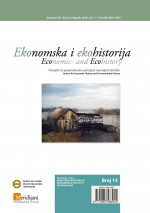Regulacijski radovi u donjem toku Drave kao temelj nesmetanog prometovanja (osvrt na drugu polovicu 19. i početak 20. stoljeća)
Regulatory Works in the Lower Course of the Drava River, as the Basis for Smooth Traffic (19th Second Half to Early 20th Century Review)
Author(s): Zlata Živaković-Kerže, Marija Benić PenavaSubject(s): Economic history, Economic development, 19th Century, Pre-WW I & WW I (1900 -1919), Transport / Logistics
Published by: Društvo za hrvatsku ekonomsku povijest i ekohistoriju - Izdavačka kuća Meridijani
Keywords: Drava; regulation works; lower Drava River; traffic; second half of 19th century; beginning of 20th century;
Summary/Abstract: The authors direct their research to re-thinking the idea to convert the Drava river, together with the Sava, into the waterways (their connection with the Adriatic sea), which in the second half of the 19th century influenced the implementation of systematic river regulation, i.e. the beginning of more serious technical treatments related to navigation of steamboats on inland waterways. In the paper, the introduction of a single water law for the entire Austro-Hungarian Monarchy, the founding of the Drava-Danube Basin (the legal successor of the Rijeka Measurement Office) and water cooperatives, will give clear contours of systematic regulatory works, which are closely related to modernization which, after opening new railways, increased investment in river traffic development. Therefore, the authors observe the regulatory works in the lower part of the Drava as the basis for undisturbed navigation in the traffic of lumber wood and crops and fruits from Slavonia to the western parts of the Monarchy, and especially in the so-called Alpine countries outside the monarchy. They explain that Drava river could be navigated without major difficulties only at the time of normal and somewhat higher water levels; the utilization of navigation on the Danube, the longest and most powerful river (from the Drava confluence to Danube near Zemun and the Drava from the Hungarian town of Barcs to Osijek and vice versa) was relatively weak, mostly due to the natural characteristics of the Drava, demanding a continuous and very large financial investment in water management works. The concluding section of the paper emphasizes that the economic objectives set for the systematic regulation of the Drava have faced great difficulties, regardless of the market’s influence, due to the permanence and long duration of those works that could only be realized by large state investments (always scarce and insufficient). The modest economic power of domestic civil entrepreneurship remained largely closed in narrow regional frameworks. Therefore, weak effects have been achieved or only partial successes to assure uninterrupted river traffic.
Journal: Ekonomska i ekohistorija - Časopis za gospodarsku povijest i povijest okoliša
- Issue Year: 2019
- Issue No: 15
- Page Range: 43-54
- Page Count: 12
- Language: Croatian

